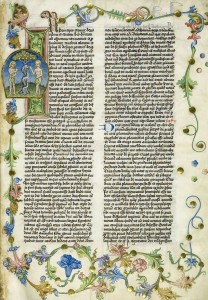Caiaphas
by Paul Zilonka, C.P.
 Our study focuses on the following: The context of Caiaphas’ life before and during his lengthy service as high priest (18-36 AD); the New Testament presentation of Caiaphas in the Gospels according to Mark, Luke-Acts, Matthew and John; his role in the Jewish and Roman trials; and popular characterizations influenced by the New Testament.
Our study focuses on the following: The context of Caiaphas’ life before and during his lengthy service as high priest (18-36 AD); the New Testament presentation of Caiaphas in the Gospels according to Mark, Luke-Acts, Matthew and John; his role in the Jewish and Roman trials; and popular characterizations influenced by the New Testament.
Historical Sources
Popular images of Caiaphas in religious circles, as with so many of the named and unnamed characters in the Gospels, generally rest on centuries of reading the biblical texts literally, along with creative preachers who tend to fill in the gaps of information, particularly by demonizing those characters who reject Jesus. Study of ancient personages is always conditioned by the limitation of authentic resources, as well as the necessity to interpret those resources in the context of their own times.
A modern media-driven culture like our own tends to want to know far more than the ancient sources may ever allow, especially in regard to the psychological makeup of people who lived in historical circumstances quite different from our modern world. This frustration can lead to a tendency to posit attributes or personal qualities based on what might have happened, or even what other people in the same era did. However, these arguments are afflicted with the perennial flaw of the silence of ancient sources on a particular person.
At first glance, sources for information about Caiaphas seem extraordinarily abundant compared to the limited resources for most of the other persons who interact with Jesus in the Gospels. Yet, we must clarify that scholarly religious study of Caiaphas examines the bare bones of historical references to him in extra-biblical sources in order to decipher points of verification with his character portrayal in the New Testament. Most of the historical information related to him pertains more to his role as high priest rather than revealing to us the inner thoughts of Caiaphas himself.
Likewise, within the context of the biblical narrative of the Passion, Caiaphas emerges as a person of interest, though the notoriety he receives at this juncture of the story does not necessarily give greater insight into his mind. “No judgment of Caiaphas’ character or motivation can make any serious claim on our attention, except as an imaginative exercise. Historically speaking, the available evidence will not permit conclusions of that sort. Nonetheless, Caiaphas’ obvious, necessary and essential link with the temple remains.” 1
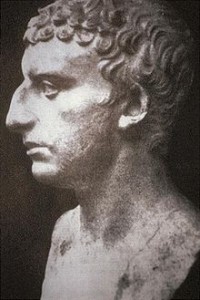
A Roman portrait bust said to be of Josephus
Born Yosef ben Matityahu
37 AD
Jerusalem, Roman Judea
Died c. 100
We are indebted to Flavius Josephus here as in other aspects of the history of Judaism in ancient Palestine in the first century CE of the Second Temple Period. Students of Josephus however, quickly point out important factors to keep in mind when reading his voluminous contributions. Namely, Josephus has a certain bias which pervades the whole of his corpus in service to some clear objectives. In the relative freedom he enjoyed in Rome under the patronage of the Flavian household after 70 AD, he did not hesitate to paint a florid image of 1st century Judaism, even though militant Zealots wrote the last page of the temple’s history, which led to its destruction by the Romans, and their subsequent siege of Masada in 72 AD.
Josephus provides background information on Judean society in Caiaphas’ time, particularly related to socio-economic matters. Having been born into a priestly family himself, Josephus gives his readers an insider’s appreciation for the temple and its sacrificial cult. He may have shared many of Caiaphas’ presuppositions about relationships between the social classes at the time. He offers us dates and information on other high priests in Antiquities 20:224-251. “When it comes to facts, Josephus is reasonably reliable, but less so in his interpretation of those facts and the motives he ascribes to individual characters. We need also to be aware of the larger rhetorical aims of his works, and to attempt to see beyond his rhetoric and bias…(This) Jewish aristocrat will be a witness of paramount importance in our quest for the historical Caiaphas.” 2
Joseph Caiaphas in Josephus’ Antiquities of the Jews
Only Josephus gives our subject’s full name as Joseph Caiaphas.3 Scholars suggest that he was probably born about 20 BC, midway through the reign of Herod the Great (37-4 BC), most likely ten to fifteen years before Jesus. While all priestly families traced their heritage back to Aaron, Moses’ brother, the family of Caiaphas also claimed a hereditary connection with Zadok who was high priest in the time of David and Solomon. Thus, they could claim a direct relationship with the priests associated with the construction of Solomon’s temple. They continued to provide this leadership down to about 200 BC.
By Caiaphas’ time, these aristocratic families enjoyed the favor of the occupying Roman forces. They were called Sadducees (after Zadok) and are reputed to have been most concerned about the preservation and purity of religious practice at the Jerusalem temple. Unfortunately, most of our knowledge of them comes from outsiders who criticized them, including the writings of the New Testament, a fact that should introduce caution into our composite evaluation of Caiaphas. When Caiaphas was about 20 years of age, he would have been formally included into the roster of priests who rendered two weeks of service at the Jerusalem temple as part of the twenty-four priestly divisions according to the yearly calendar. Zechariah, the elder father of John the Baptist fulfilled this same function (Luke 1: 5, 8).
Caiaphas grew up when Herod the Great was in the midst of much construction in Jerusalem and the temple environs. Herod’s son Archelaus succeeded him with responsibility for Judea (4 BC-6 AD). Both Herod the Great and Archelaus had appointed high priests. But with the forceful intervention by the Roman senator Quirinius in 6 AD, Herodian influence in Jerusalem ceased, despite the continuing presence of another son, Herod Antipas, in Galilee as a puppet of Roman domination.
Rome henceforth exercised its prerogative of power by selecting the high priest. Quirinius appointed Ananus, the son of Seth, in 6 AD. The New Testament calls this high priest Annas, so that convention will be followed in this article. This was the beginning of a unique dynasty among priestly families, although Annas himself was deposed by the procurator Valerius Gratus in 15 AD.4 There may not have been any specific grounds for this change other than as a way for Gratus to assert his own assumption of authority in the region. Perhaps this is made more clear by the fact that later Gratus willingly appointed other descendants of Annas. However, a tumultuous period of temple leadership followed when Annas was removed after his decade of one-man rule. In rapid succession, Ishmael of Phabi, Eleazar, a son of Annas who had been high priest earlier, and Simon, the son of Camithus served briefly. The continuing significance of Annas as a power over the office of high priest seems evident since Josephus lists five of his sons as successors, along with Caiaphas (whom John 18:13 names as a son-in-law of Annas). Caiaphas had the longest tenure (18-36 AD) of a high priest between 16 and 62 AD. 5
Valerius Gratus appointed Caiaphas around 18 AD, a strategic step which solidified a new era of collaboration between the high priesthood at Jerusalem and Rome’s procurators in this eastern Mediterranean portion of the Roman Empire, which often simmered with rebellious movements. Caiaphas had eight years seniority in his priestly office by the time that the new procurator, Pontius Pilate, took up residence in Caesarea Maritima in 26 AD. For the next decade, he and Caiaphas would build a working relationship that would generally rely on the high priest to appease Rome at the expense of the Jewish revolutionary spirit in order to keep some semblance of peace.
“Whatever later Jews and Christians may have thought of Caiaphas and Pilate, they were in their own day skillful masters of pragmatic politics which at least minimized major disturbances and bloodshed. As a result, from the viewpoint of high-level Jewish and Roman politics in Judea, the time of Jesus’ adulthood was the most stable (though not entirely peaceful) period in the 1st century C.E… If Caiaphas and Pilate worked well as a team at the time of Jesus’ trial and execution, it was because they were well practiced in the game.” 6 This close association may, perhaps, be confirmed by the fact that Caiaphas was deposed from his post in 37 AD, just after Pilate was removed by his successor Vitellus in 36 AD.
Other sources for information about the rituals of the temple in this period and comments on the role of the high priests can be found in Ben Sira 50, Philo of Alexandria (15 BC-50 AD) who was a contemporary of Caiaphas, the Dead Sea Scrolls, the Testament (or Assumption) of Moses, the eighteen Psalms of Solomon and the letter of Aristeas. The use of rabbinic writings which took final shape from the late first century onward may preserve some information about the period of Caiaphas, and especially, the conduct of a capital trial. However, the same caution must be exercised here as with uncritically accepting the evidence of Josephus. Attention is necessary to the idealistic concerns of this literature looking back on a previous period of history which has now been ruthlessly eliminated by the crushing blow of Roman imperial authority.
New Testament Sources
Caiaphas plays an important part in the Passion story comparable to that of Pontius Pilate since all four Gospels associate these men with each other in the final hours of Jesus’ life. Yet Caiaphas is also generally portrayed as less immediately responsible than Pilate for the death of Jesus. Although Jesus was handed over to the Romans by the temple leadership, he was in fact executed by Roman soldiers under Pilate’s order.
Redaction critical study over the past century has drawn attention to the increasing level of division between the Jewish community and the Jewish followers of Jesus in the 2nd and 3rd generation when the Gospels were being written. The destruction of the temple in 70 AD appears to have influenced the way the four Gospels present an intensely negative portrayal of Jewish leaders in relation to Jesus during his ministry. This is particularly true when Jesus visits Jerusalem. Taking the four Gospels at a glance, the image of Caiaphas morphs in various ways from being a general representative of the will of the Jerusalem leadership in Mark all the way to the highly idiosyncratic role of prophet of the redemptive significance of Jesus’ death in John.
Caiaphas in Mark, Matthew, Luke-Acts
Mark mentions no high priest by name. Matthew mentions Caiaphas by name only in regard to the plot against Jesus (26:3) and after Jesus is arrested (26:57). Luke does not mention Caiaphas in the Passion narrative, although he refers to “the high priest’s servant” (22:50) and “the house of the high priest (22:50).”
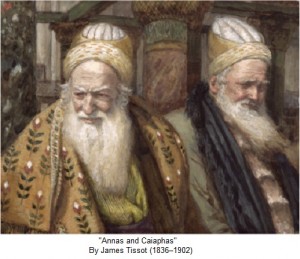 Luke 3:1-2 dates the ministry of John the Baptist by reference to the reigns of Tiberius, Pontius Pilate, Herod Antipas, Philip, and “the high priesthood of Annas and Caiaphas.” This description of Annas and Caiaphas together does not reflect the historical chronology given by Josephus. However, it is unlikely that Annas has replaced his son-in-law in what would have been 28-29 AD. Rather this remark appears to indicate that a former high priest with close connection to the present high priest might retain his past title, not unlike certain political leaders today who are addressed by their former title long after they have left office.7 This may also explain why Annas is also called high priest in Acts 4:6 which takes place shortly after the death and resurrection of Jesus. Caiaphas is mentioned in a secondary place on this occasion as well.
Luke 3:1-2 dates the ministry of John the Baptist by reference to the reigns of Tiberius, Pontius Pilate, Herod Antipas, Philip, and “the high priesthood of Annas and Caiaphas.” This description of Annas and Caiaphas together does not reflect the historical chronology given by Josephus. However, it is unlikely that Annas has replaced his son-in-law in what would have been 28-29 AD. Rather this remark appears to indicate that a former high priest with close connection to the present high priest might retain his past title, not unlike certain political leaders today who are addressed by their former title long after they have left office.7 This may also explain why Annas is also called high priest in Acts 4:6 which takes place shortly after the death and resurrection of Jesus. Caiaphas is mentioned in a secondary place on this occasion as well.
Caiaphas’ responsibility for the overall conduct of affairs at the Jerusalem temple may have some bearing on his decisive handling of Jesus who came to Jerusalem with some show of public support. This is especially true if all four Gospels are to be believed in their depiction of Jesus’ entry to the acclaim of crowds who see some relation between his arrival there and their messianic hope. In the synoptics, little mention is made of the Jerusalem temple and its cult, nor does Jesus visit the temple until the last days of his life. This delayed arrival at Jerusalem may be an artificial tailoring of Jesus’ actual journeys during the ministry in order to give prominence to the visit in which he was executed.
The Johannine tradition of Jesus visiting Jerusalem for several different feasts over a number of years may preserve a historical tradition based on fact, although here too the evangelist’s creative perspective may be at work since these several feasts in John become occasions for presenting Jesus as one who replaces the Jewish feasts and institutions by fulfilling them in some way (Passover and the temple of his body 2:19-22; Passover and new bread from heaven 6:25-65; Tabernacles and Hanukkah and the light of the world 7:2 and 10:22; Passover and the paschal lamb 19:14).
Caiaphas in John
Caiaphas is more important personally in John than in the synoptics. He is named in 11:49; 18:13, 14, 24, 28. Key sections in John relate to Caiaphas’ role as high priest. He leads the council meeting in John 11, but is not present when Annas interrogates Jesus (18:19-23). Though Jesus is sent to Caiaphas (18:24), there is no mention of any judicial action by the Sanhedrin as in the synoptic traditions. Even with this enhanced presence of Caiaphas in John, the emphasis falls more on his role as high priest, most likely to contrast him to Jesus who was not born into the hereditary priesthood of Israel, nor proclaimed as such in his ministry. The Passion narrative in John saturates the portrait of Jesus with priestly elements as Jesus lays down his life for his sheep (10:15). Though Jesus was not born into a priestly family, he wears a seamless robe reminiscent of the seamless robe of the high priest which Caiaphas tears in response to alleged blasphemy by Jesus. 8 The soldiers rolled dice for the common garments of Jesus in the synoptics, (Matt 27:35; Mark 15:24; Luke 23:34). However, in John, the motive for their action is to avoid tearing the seamless robe so that only one would win it (John 19:23-24). Their profane action takes on even greater significance when it is explained as the fulfillment of a text in Psalm 22, a Passion psalm which serves repeatedly as a structural element in all the Gospel narratives of the suffering and death of Jesus.
Jesus before Caiaphas and the Jewish Authorities
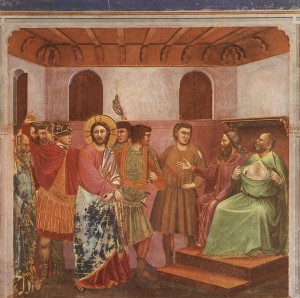 In all four Gospels, Jesus is brought before the Jewish authorities in various ways, including interrogation and judgment. Mark 14:53-15:1; Matthew 26:57-27:2; Luke 22:54-23:1; John 18:12-19:28 cover the progression from the initial hearing of Jesus to his transfer to Pilate.
In all four Gospels, Jesus is brought before the Jewish authorities in various ways, including interrogation and judgment. Mark 14:53-15:1; Matthew 26:57-27:2; Luke 22:54-23:1; John 18:12-19:28 cover the progression from the initial hearing of Jesus to his transfer to Pilate.
Josephus and the New Testament substantially agree on the description of the Jerusalem Sanhedrin. In each case, this assembly included chief priests, scribes, rulers and influential citizens or elders who played an administrative and judicial role in the Judean region which was put under their governance in 6 AD. 9 While the Pharisees might have been present among the scribes, they are only specifically mentioned in conjunction with the Sanhedrin in John 11:46, 47, 57; 18:3.
The burden of Jewish responsibility is attributed to the elders and chief priests, along with the high priest, though neither Mark nor Luke mentions the name of Caiaphas. Luke focuses on ‘high priests’ as a group (families) in regard to judicial procedure (Luke 9:22; 19:47; 22:2,4,52,66; 23:4, 10, 13; 24:20). Although Luke shares with the other evangelists a critical view of the Pharisees in their religious conflicts with Jesus, he alone records an element of their concern for Jesus’ physical welfare that echoes some of the political distance between this lay group of Jews in the holiness tradition and a ruler like Herod Antipas. “At that time some Pharisees came to him and said, ‘Go away, leave this area because Herod wants to kill you’” (Luke 13:31). Though Pharisees played some role in the Sanhedrin (e.g. Nicodemus, John 3:1, 7:50), their cooperation in the judgment against Jesus seems deliberately played down in contrast to the machinations attributed to the priestly families who managed all aspects of the practices of worship within the temple precincts.
Matthew 26:3, 57 and John 11:49; 18:13, 14 do name Caiaphas. They even dwell on his words and actions, adding particularly incriminating elements to the drama. “Matthew’s picture, then, is of deadly opposition from those most intimately associated with the temple. Caiaphas is emblematic of the opposition without being an instigator of it” 10
John in a special way colors his portrait of Caiaphas the man with a persona for Caiaphas as high priest who prophesies the death of Jesus, an example of the pervasive influence of the conviction that the death of Jesus was fulfilling biblical prophecy. This is one of the determining principles in using Psalms 22 and 69, which underlie the structure of the Passion Narrative in all four Gospels in different ways. John 11:47-53 refers to an earlier meeting attended by at least some of the members of the Sanhedrin. Caiaphas bluntly tells the assembled group that they must recognize the tenuousness of their political situation. “You know nothing, nor do you consider that it is better for you that one man should die instead of the people, so that the whole nation may not perish” (11:49-50). This certainly captures the state of affairs that Caiaphas knew well in his balancing act with Pilate’s ruthless attitude toward Jewish zealotry. Caiaphas was making a realistic political point about avoiding an intrusion of Roman authority against the populace.
However, the evangelist nuances the meaning of Caiaphas’ words for his own theological purpose, attributing prophetic power to Caiaphas who was “high priest that year,” that is, the year of Jesus’ execution. 11 He prophesied that Jesus was about to die “for the nation, and not for the nation only, but to gather into one the dispersed children of God” (11:51-52). For this evangelist, Caiaphas was unconsciously giving voice to the true nature and significance of Jesus’ death. This power of prophecy is attributed to other high priests in accounts by Josephus. 12
The scene of the expulsion of vendors from the temple precincts may well point to the sensitive point at which Caiaphas could no longer tolerate Jesus. The moneychangers served a useful purpose because they allowed worshipers to make their temple offering after exchanging their Roman coins for Tyrean shekels at a controlled rate. But the sale of animals within the temple precincts, as necessary as they were for worship, was possibly an intrusion from a former location. “On balance it would appear that Caiaphas did engineer the installation of vendors in the temple, that Jesus reacted with force, and that the collision of the two was finally adjudicated by Pilate, Caiaphas’ protector.” 13
Caiaphas at the Trial before Pilate
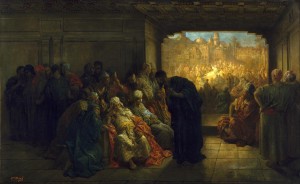 John’s version of Jesus’ imprisonment by the high priestly family portrays the whole affair as a secretive inquiry before Annas (John 18:19-23) followed by the transfer of Jesus to Caiaphas (John 18:24) for an indeterminate amount of time in which nothing apparently happens before Jesus is handed over to Pilate. “For all the differences between the Synoptics and John, there is a consensus that, following a hearing and high priestly interrogation, it was resolved to dispatch Jesus to Pilate (Matt 27:1-2; Mark 15:1; Luke 23:1; John 18:28)” 14
John’s version of Jesus’ imprisonment by the high priestly family portrays the whole affair as a secretive inquiry before Annas (John 18:19-23) followed by the transfer of Jesus to Caiaphas (John 18:24) for an indeterminate amount of time in which nothing apparently happens before Jesus is handed over to Pilate. “For all the differences between the Synoptics and John, there is a consensus that, following a hearing and high priestly interrogation, it was resolved to dispatch Jesus to Pilate (Matt 27:1-2; Mark 15:1; Luke 23:1; John 18:28)” 14
The difference in John’s chronology for the official Passover that year has some bearing on the role Caiaphas may have played in the high priestly interaction with Pilate, the Roman governor. Unlike the synoptic portrait of Jesus as celebrating the Passover meal with his disciples (though traditional elements of that meal are lacking in the synoptic scene), John describes the priestly contingent as coming to Pilate’s residence on the morning of the Day of Preparation. After the lambs are slain that afternoon, the Passover would be eaten that evening, the beginning of Sabbath. By then, the body of Jesus would already have been laid to rest. Caiaphas is not specifically mentioned in the scene before Pilate, but John 18:28 does insist that those who brought Jesus did not enter the praetorium lest they be defiled and be unable to eat the Passover.
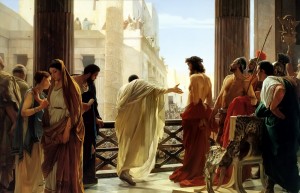 Both Josephus and the Gospels highlight the close relationship of Caiaphas and the Roman administration. The prevailing mood of fearfulness from decades of Roman occupation is echoed in Caiaphas’ fearful reasoning in John 11:48. “If we leave (Jesus) alone, all will believe in him, and the Romans will come and take away both our land and our nation.” Since 26 AD, Caiaphas and Pilate had taken the measure of one another and Caiaphas had known how to keep revolutionary sentiment from boiling up in such a way that the fragile accord in place should not be disturbed. It is not likely that these pragmatic leaders understood the nuances of Jesus’ preaching about the kingdom of God. To them, he was probably just another political version of John the Baptist whom Herod had dealt with decisively through beheading. For whatever reason, they adopted this approach as their own solution: “cut off the head of the movement with one swift, preemptive blow. The headless movement, so completely centered and dependent on one charismatic prophet who wielded all authority within the group, would quickly dissolve. In the famous last words of many a politician: it seemed like a good idea at the time.” 15
Both Josephus and the Gospels highlight the close relationship of Caiaphas and the Roman administration. The prevailing mood of fearfulness from decades of Roman occupation is echoed in Caiaphas’ fearful reasoning in John 11:48. “If we leave (Jesus) alone, all will believe in him, and the Romans will come and take away both our land and our nation.” Since 26 AD, Caiaphas and Pilate had taken the measure of one another and Caiaphas had known how to keep revolutionary sentiment from boiling up in such a way that the fragile accord in place should not be disturbed. It is not likely that these pragmatic leaders understood the nuances of Jesus’ preaching about the kingdom of God. To them, he was probably just another political version of John the Baptist whom Herod had dealt with decisively through beheading. For whatever reason, they adopted this approach as their own solution: “cut off the head of the movement with one swift, preemptive blow. The headless movement, so completely centered and dependent on one charismatic prophet who wielded all authority within the group, would quickly dissolve. In the famous last words of many a politician: it seemed like a good idea at the time.” 15
Popular Characterizations of Caiaphas
Popular imagination, fueled by the biblical narratives, has consistently cast Caiaphas in the role of persecutor of Jesus. This negative portrait has continued to hold sway in devotional literature about the Passion of Jesus. Traditional “passion plays’ in the spirit of Oberammergau in Germany, as well as in local parish productions in churches in Holy Week, continue to influence new generations of believers with a one-sided version of this man’s unique role in judging Jesus. The constant production of new biblical films keeps alive the perennial image of Caiaphas as a manipulative engineer of the destruction of Jesus in order to preserve the political status quo and the lucrative enterprise which the temple was in his time. As happens in so many other instances where the biblical text is sparse in details and dialogue, moralistic piety and inventive scriptwriters often fill in the gap.
 At two thousand years distance from Joseph Caiaphas, there is no way for us to get inside the mind and heart of this man. For some, Caiaphas will remain a malicious character, an example of a mean spirited person who cannot rest until he has accomplished his goal, the elimination of any threat to his own security. But to be fair, we hear no independent voice in Josephus or the New Testament which takes his side in what was most likely a very complicated historical and religious matter from his point of view. We cannot know what hesitation might have kept him awake at night as the news about Jesus of Nazareth filtered into Jerusalem in the months leading up to that fateful week which the Gospels recount. His life as high priest went on for several more years. There is no indication in our sources that his life was affected one way or the other by the events of that Passover time in that most significant year of the death of Jesus.
At two thousand years distance from Joseph Caiaphas, there is no way for us to get inside the mind and heart of this man. For some, Caiaphas will remain a malicious character, an example of a mean spirited person who cannot rest until he has accomplished his goal, the elimination of any threat to his own security. But to be fair, we hear no independent voice in Josephus or the New Testament which takes his side in what was most likely a very complicated historical and religious matter from his point of view. We cannot know what hesitation might have kept him awake at night as the news about Jesus of Nazareth filtered into Jerusalem in the months leading up to that fateful week which the Gospels recount. His life as high priest went on for several more years. There is no indication in our sources that his life was affected one way or the other by the events of that Passover time in that most significant year of the death of Jesus.
Bibliography
Bond, Helen K. Caiaphas: Friend of Rome and Judge of Jesus? Louisville, KY: Westminster Knox Press, 2004.
Brown, Raymond E. The Death of the Messiah. 2 vols. New York: Doubleday, 1994.
Chilton, Bruce. “Caiaphas” in David Noel Freedman, ed. Anchor Bible Dictionary (New York: Doubleday, 1992) 1.803-806.
Fitzmyer, Joseph A. The Gospel according to Luke I-IX. AB 28. New York: Doubleday, 1981.
Josephus, Flavius. Antiquities of the Jews. Cambridge, MA: Harvard University Press, 1926-81.
Meier, John. A Marginal Jew: Rethinking the Historical Jesus. 4 vols. New York: Doubleday, 1991-2009.
VanderKam, James C. From Joshua to Caiaphas: High Priests after the Exile. Minneapolis MN: Augsburg Fortress, 2004.
1 Bruce Chilton, “Caiaphas” in David Noel Freedman, ed. Anchor Bible Dictionary (New York: Doubleday, 1992) 1. 805.
2 Helen K. Bond, Caiaphas: Friend of Rome and Judge of Jesus? (Louisville, Kentucky: Westminster Press, 2004) 19.
3 Flavius Josephus, Antiquities of the Jews (Cambridge, MA: Harvard University Press, 1926-81) 18.2.2; 18.4.3.
4 Antiquities 18.2.1,2.
5 Antiquities 20. 9,1.
6 John Meier, A Marginal Jew: Rethinking the Historical Jesus (4 vols. New York: Doubleday, 1991-2009) 3.296-297.
7 Joseph A. Fitzmyer, The Gospel according to Luke I-IX, AB 28 (New York: Doubleday, 1981) 548.
8 Descriptions of the high priest’s vestments are found at Ex 28:1-43; 39:1-31; Lev 8:5-9; Sir 45:9-12; Antiquities 3. 172-178 and Aristeas 96-99.
9 Raymond E. Brown, The Death of the Messiah (2 vols. New York: Doubleday, 1994) 1. 342-343.
10 Chilton, Caiaphas, 804.
11 Brown, Death of the Messiah, 1. 405.
12 Antiquities 11.8.4; 13.107.
13 Chilton, Caiaphas, 806. Cf. Bruce Chilton, A Galilean Rabbi and His Bible (GNS, 8: Wilmington, DE: Glazier, 1984) 18.
14 Chilton, Caiaphas, 805.
15 Meier, Marginal Jew, 3.625.

